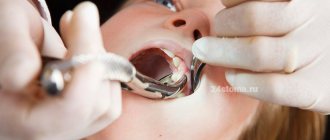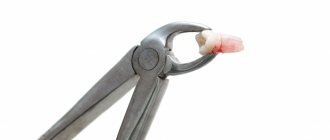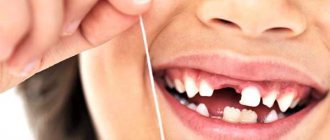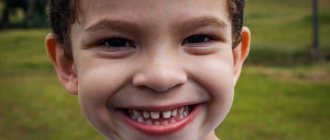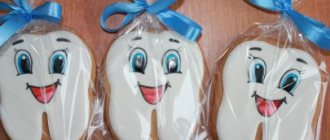Author of the article:
Soldatova Lyudmila Nikolaevna
Candidate of Medical Sciences, Professor of the Department of Clinical Dentistry of the St. Petersburg Medical and Social Institute, Chief Physician of the Alfa-Dent Dental Clinic, St. Petersburg
In the life of every baby and every mother, there comes an exciting moment when the first teeth erupt. And, alas, along with the joy of a new independent stage in the life of a child, new problems interfere in the lives of children and parents. The child's first tooth is accompanied by a very painful condition. Is it possible to alleviate these unpleasant manifestations of growing up? Of course you can. How? Let's figure it out together.
When do the first teeth appear?
Usually a baby's first baby tooth is at 6 months. Although some children have their first teeth appearing as early as 4 months of age, others have to wait as long as 7 months for their first incisors. By the way, both such an early and such a late appearance is considered the norm. At 6-8 months, the central lower incisors appear.
- At 8-12 months, the central upper incisors grow;
- 10-13 months – second upper and lower incisors;
- 1-1.5 years – primary molars;
- 1.5-2 years – fangs;
- 2-2.5 years – second primary molars.
Thus, by the age of two, the baby already has 18 teeth in its mouth. But it is the first incisors that cause the baby the most inconvenience.
What to do when teeth grow in two rows
With “shark” jaws, the most reasonable solution seems to be the removal of excess milk units. And they did this for a long time. The result of hasty decisions showed that hasty removal of primary incisors and fangs leads to the opposite result and the formation of a malocclusion. After this, pediatric dental surgeons began to see children only as prescribed by the orthodontist - after professional consultation with a specialist.
An orthodontist is the first doctor you should go to when teeth grow in two rows. The doctor will assess the prospects for the formation of the dentition, send you for an x-ray to accurately determine the rudiments of permanent teeth and make the right decision. And this will not always be immediate removal of a baby tooth!
Based on the results of the diagnosis and examination, the orthodontist can advise:
- increase the amount of solid food in the child’s menu - provide the missing pressure on the baby tooth, causing it to loosen and fall out;
- wait for the natural change of teeth so that the permanent unit moves into its intended place under the influence of other teeth and under the pressure of the tongue muscles;
- remove primary incisors and canines to forcefully free up space.
The latter purpose is typical for parallel growing teeth and firmly standing primary units, since this is the only case when there are no natural prerequisites for root resorption and normal bite changes.
How to understand that teeth have started to cut?
The following symptoms will indicate that a child is getting his first baby tooth:
- severe crying, frequent whims of the baby;
- increased salivation;
- slight increase in temperature;
- frequent excitability;
- refusal of food;
- upset stomach (diarrhea).
Of course, the above symptoms individually can indicate not only that the child is getting his first teeth. For example, whims and frequent excitability in a baby can be caused by stress due to moving to a new apartment, fever by a cold, and diarrhea by an allergy to a particular product. Usually, the eruption of the first teeth in children provokes several, or even all, of these signs at once.
Features of the period and symptoms of the eruption of the first teeth.
DATES OF TEETHING ARE INDIVIDUAL FOR EACH BABY AND DEPEND ON A NUMBER OF FACTORS: NUTRITION, HEREDITY, ETC. THIS IS WHY YOU SHOULD NOT WORRY MUCH IF THE LONG AWAITED APPEARANCE OF YOUR FIRST TEETH IS DELAYED.
PHOTO: Gums of a child at 6 months. Before the first baby teeth erupt, the gums in the area of the future teeth turn slightly white due to tooth pressure.
It's hard to miss when children's first teeth appear. As the tooth erupts, it “tightens” the mucous membrane (the tooth can be felt with your finger under the mucous membrane) and, having “broken through” it, ends up in the oral cavity. In some children, a bluish “bump” or “ball” with transparent contents forms on the mucous membrane above the erupting tooth. This is a small eruption cyst that usually breaks out on its own WITHOUT outside help (despite the menacing name), although sometimes the intervention of a pediatric dentist is required.
The first teeth that appear may be located asymmetrically and “not evenly” - this is the norm. Such dental disorder has the right to exist until the eruption of 16 teeth: baby teeth are independently ordered as they erupt, aligning each other. This is facilitated by the intake of solid food, pressure of the tongue and lip muscles.
In a normal primary occlusion, gaps form between the primary incisors and canines (on average 1 mm), which is normal and a sign that the permanent wider incisors will have enough space in the dentition during the period of physiological change of teeth. The absence of these spaces indicates a lack of space for permanent teeth.
In most cases, teething does not cause the child any discomfort, although sometimes the process of teething can be accompanied by “itching” of the gums and lead to sleep disturbances in the child, causing a lot of trouble for the child and his parents.
When should you worry?
The listed signs of the appearance of the first baby tooth should not bother mom, dad and grandmother too much. The following symptoms may be a reason to contact your pediatrician:
- Early appearance of the first teeth. In rare cases, newborns develop teeth immediately after birth. This may indicate endocrine pathology and requires examination by an endocrinologist.
- A significant delay in teething may also indicate various metabolic disorders in children and requires medical intervention.
- Incorrect appearance order . If, instead of the baby’s first incisors, molars or fangs begin to peck, such disharmony may indicate anomalies in the baby’s development or be a consequence of illnesses that the woman suffered during pregnancy.
- Temperature above 39 degrees. When the first teeth erupt in children, the temperature rises slightly. If your baby becomes hot and the high temperature lasts for several hours, call a doctor immediately.
A child's teeth grow in two rows
With proper development of the jaw at the right age, permanent teeth begin to erupt and put pressure on the roots of the milk units.
Under this influence, the roots dissolve - the baby tooth becomes mobile, it wobbles and then falls out. This is a normal change in bite, the algorithm of which is known to most. But in rare cases the situation develops differently:
- when the germ of a permanent tooth and the root of the milk tooth are located in parallel planes, there is no pressure on the roots, and the permanent tooth grows in close proximity to the milk tooth;
- when the permanent one erupts quickly, and the roots of the milk unit have not yet resolved, the tooth does not fall out, and the permanent one has to bend and grow at an angle;
- when a child has a supernumerary set of teeth.
Various reasons - one result: the child’s teeth grow in the second row, threatening to ruin the permanent bite.
How to help your baby?
To alleviate the symptoms accompanying teething in a child, parents can use one of the following methods:
- Let your baby chew on a crust of bread . Such manipulations will provide gum massage. However, you need to carefully monitor your child so that he does not choke on the spicy crumbs.
- Wipe off saliva from your baby's skin every half hour . Excessive salivation irritates the skin and can lead to rashes, dry skin and allergic reactions.
- Massage your baby's gums . If your baby is suffering from pain and inflammation of the gums, try gently massaging the gums with a clean finger. But, before you start the massage, remember not to lubricate fragile baby gums with alcohol or apply tablets to the tissues.
The first baby tooth fell out: what to do?
Every child reacts differently to losing their first tooth. Some people rejoice at the first arrival of the Tooth Fairy, while others worry about the pain. But the loss of the first tooth means only one thing - permanent “adult” teeth are on their way. Typically, baby teeth begin to fall out around the age of six or seven and end between the ages of ten and twelve .
After your child's first tooth falls out, be sure to take good oral care until the molars emerge.
Wipe your baby's gums
You've probably used a sterile soft cloth or gauze to clean your baby's gums as a child. Do the same after the first tooth falls out, bypassing the wound after the tooth falls out. Also, ask your baby to put salted water in his mouth to sterilize it (this may be unpleasant, but it's definitely worth it). Intense rinsing movements are not necessary so as not to damage the protective blood clot in the wound. After a tooth falls out, bleeding may begin. It should stop after 5-10 minutes , otherwise call your dentist.
Use a local anesthetic
Immediately after a tooth falls out, your child may experience pain or discomfort. Over-the-counter local anesthesia is a quick and safe way to relieve minor irritation after the bleeding has stopped. If the pain does not subside, be sure to consult a doctor.
Give your child an anti-inflammatory drug
Although you can make sure your child does not move the tooth and waits for it to fall out on its own, this is difficult to control. Excessive wobbling of the tooth can cause swelling: use an over-the-counter pediatric inflammation reliever. If the swelling does not go down within a day, see your dentist to avoid infection.
Do not brush the socket
According to experts , in some children, permanent teeth appear in place of the lost milk teeth within a few weeks, but for other children this may take about three to four months . Either way, the area around the lost tooth will be tender at first, and even a soft-bristled brush may irritate it. Tell your child to thoroughly brush all other teeth, but not to touch the socket itself with a brush for several days.
Take proper care of your mouth
Poor care of baby teeth can affect the development of permanent teeth, and for good reason. Experts say that baby teeth maintain space in a person's jaw for the eruption of molars. Since each child's permanent teeth eruption schedule is different, daily oral care is the best way to protect teeth from decay and prevent the risk of developing plaque or early gingivitis.
Choose a fluoride toothpaste for children that has a pleasant, fruity scent. In addition, it is very important to teach your child how to properly care for an empty socket and maintain daily oral hygiene. We recommend you:
- Teach your child to properly brush their teeth twice a day with a soft brush.
- Check your gums for inflammation together to make sure your child is taking good care of them.
- Use dental floss with your child at least once a day.
- Avoid excessive consumption of sweets.
Proper oral care is a necessary habit for all children. But the best way to survive losing your first tooth is to make sure the Tooth Fairy is nearby, waiting for her moment.
You may also be interested in
CHILDHOOD
Finger wipes from 0 to 3 years ASEPTA BABY
For gentle oral hygiene of babies and massage of gums during the eruption of the first teeth
More about the product
CHILDHOOD
Children's gel toothpaste from 0 to 3 years ASEPTA BABY
Designed for gentle care of baby's gums and baby teeth
More about the product
Asepta Baby wet wipes with xylitol, calcium pantothenate, chamomile and witch hazel extract, intended for children 0-3 years old, will be effective pain-relieving assistants and an alternative to a toothbrush for little ones.
The napkin perfectly cleans all surfaces in the oral cavity, reduces the risk of inflammation and prevents the growth of bacteria in the oral cavity.
Where to put baby teeth
Throwing away baby teeth that a child identifies as part of himself is fundamentally wrong. And ancient signs say that proper handling of baby teeth promises health and well-being for the child.
That's why the Tooth Fairy is already waiting for a tooth!
The legend of the Fairy has been floating around the world for almost 150 years. The writer Luis Coloma first told about it to the eight-year-old King of Spain Alfonso XIII. And to this day there is not a single refutation of the fact of the existence of this good sorceress.
But how can we send valuable cargo to Fairy? Wait until evening and let the child put the tooth under the pillow himself. Be sure to say out loud the time-tested spell: “Mouse, mouse, bring the Fairy a milk tooth, and bring me a new one - bone and durable.” After this, the baby can go to bed. Surely in the morning he will find under his pillow, instead of a tooth, a small gift from the good Fairy, who is surprisingly similar to his mother.
According to legend, transportation of the tooth to its destination is carried out with the utmost care, as befits the handling of valuable cargo.
A caring gray mouse carefully takes a tooth from under a sleeping child’s pillow and gives it to the little mice, who know the way to the magical palaces very well. There they are greeted by the blond Tooth Fairy with a dazzling smile.
But why does the Fairy need millions of children's teeth from all over the world? Legend has it that she builds them into a wonderful snow-white palace with openwork walls, vaulted ceilings and carved windows. Under the rays of the sun, small teeth shine like pearls, creating a fantastic flickering light inside the palace.
Colorful, joyful dreams are born in this magnificent palace. With a light breeze, they leave the palace and scatter into the beds of those children who washed their face and brushed their teeth before going to bed. During sound sleep, children grow quickly and gain strength.
Experts' opinion
The effectiveness of ASEPTA wipes has been proven in the laboratories of the VERTEX company. Products have:
- Certificate of Conformity No. ROSS RU.AG81.N01070;
- Certificate of Conformity No. ROSS KR.AG81.H01815;
- Certificate of state registration No.RU.47.01.05.014.E.000002.01.18.
In addition, a study of the clinical effectiveness of the use of therapeutic and prophylactic agents of the ASEPTA series in the treatment of inflammatory periodontal diseases in children and adolescents, conducted at the Department of Pediatric Dentistry of the Novosibirsk State Medical University, proved that after the use of Asepta therapeutic and prophylactic agents in children There was a decrease in signs of inflammation in periodontal tissues (disappearance of swelling, bleeding gums).
Medicines for teething in children
When your baby is in pain, you would like to have a reliable, effective medicine that you can give and sleep peacefully. As in the case of colic, when teething, the pharmacy will offer you a variety of remedies. Pediatric experts do not advise giving any medications without a doctor's permission.
Why? Homeopathic medicines are divided into true homeopathic (containing no active substance at all, and therefore ineffective) or pseudo-homeopathic. The latter contain some amount of plant components (usually chamomile and other, more exotic plants). The first ones do not work under any conditions, including teething in children, but at least they are harmless. Homeopathic remedies for pain containing belladonna (which was not even always listed in the composition) caused many deaths and were therefore strictly prohibited in developed countries.
In our country, the Commission of the Russian Academy of Sciences recognized homeopathy as a pseudoscience, but, unfortunately, there is no strict ban on potentially dangerous drugs. Since manufacturers do not always indicate belladonna in the composition, we recommend that you generally refrain from using any homeopathic remedies for teething pain in children.
Another case is gels with a local anesthetic drug (their name ends in “-caine”: usually benzocaine or lidocaine). Medicines like these are “freezes” that are injected into the gums when treating teeth. Although these drugs are obviously effective, they have also caused many child deaths. Substances of this group affect the functioning of the heart, because the gel is quickly washed off with saliva, and the child swallows it. It is especially dangerous if the parent uses a higher dose than recommended in the instructions. This happens often because these drugs only relieve pain for a few minutes. When the baby starts crying again, the parents apply more, often exceeding the dose. Now professional communities of doctors do not recommend the use of products with local anesthetics, but this does not stop their widespread advertising.
What to do when children are teething?
The most natural and one of the most reliable ways to reduce pain is cold. Pick up an item - a “rodent” that can be put in the refrigerator. Freezing them is not recommended because it can damage the baby's delicate gums.
Often children prefer to gnaw on their parent's finger or, unfortunately, on their mother's breast. But parents may not have enough patience for a long time, so it is better to find a suitable teether.
It should be:
- whole and durable (the child should not bite off pieces that could cause choking);
- without ropes and beads (the rope can pinch the neck or break, creating a risk of choking on a bead);
- without paint with toxic components;
- just clean (no need to disinfect it).
You can refrigerate the fruit puree or put a few wet cloth toys in the refrigerator so you can replace them.
Of course, children chew not only objects that are ideal for this. But if with a teether made of one piece of silicone or a mitten with a silicone pad the child can be left alone in the playpen for some time, then with a bunch of small objects on a string around the neck or a bracelet made of beads, the same as with some fruit or vegetable, you need to look after it.
If cooling does not help, and the stress of teething is very severe, discuss taking pain relievers and fever reducers (ibuprofen is most often used) with your pediatrician. To be on the safe side, consult your doctor, but a single dose by weight (for ibuprofen is 10 mg/kg), given once at night for 3-4 days of active teething, will not cause harm.
Timeline of teething
Most babies' first teeth emerge between 6 and 7 months of age, but this may happen earlier or later. In general, your baby's teeth will most likely appear in the following timeline windows:
6-7 months
During this time, the process of erupting the first teeth begins. The first teeth to emerge are usually the lower central incisors, which are the two middle teeth at the bottom. Children at this age become more active. They begin to grab and pull objects towards themselves, transfer objects from one hand to another, and may even begin to crawl. It is important to keep an eye on small objects within your baby's reach as he will want to put everything in his mouth during teething!
From 8 to 13 months
Between 8 and 12 months, your baby's upper central incisors will emerge. Additionally, sometime between 9 and 13 months, they will have upper and lower teeth next to their upper central incisors (called lower and upper lateral incisors). In addition to teething, it is important to understand that other important gross motor milestones are reached during this developmental window. Most babies are able to sit up, stand up without assistance, take their first steps, pick up and throw objects, roll a ball, and grasp objects.
From 13 to 20 months
Typically, between 13 and 16 months, your baby's first molars will appear on the bottom and top at about the same time. Soon after this, their canines will appear on both the top and bottom rows, around 16 to 20 months.
From 20 to 30 months
At the final stage of teething, the baby's back teeth or second molars appear in the bottom row. Although most teething symptoms appear the same in both babies and toddlers, there are some differences as your baby gets older. First of all, your baby can now tell you about his discomfort and pain, unlike non-verbal babies. On the other hand, many babies will not show any signs of discomfort and will not complain at all about pain when moving their molars. For other babies, the pain may be significantly worse because their first molars are larger than their other molars. They may even complain of headaches or jaw pain!
